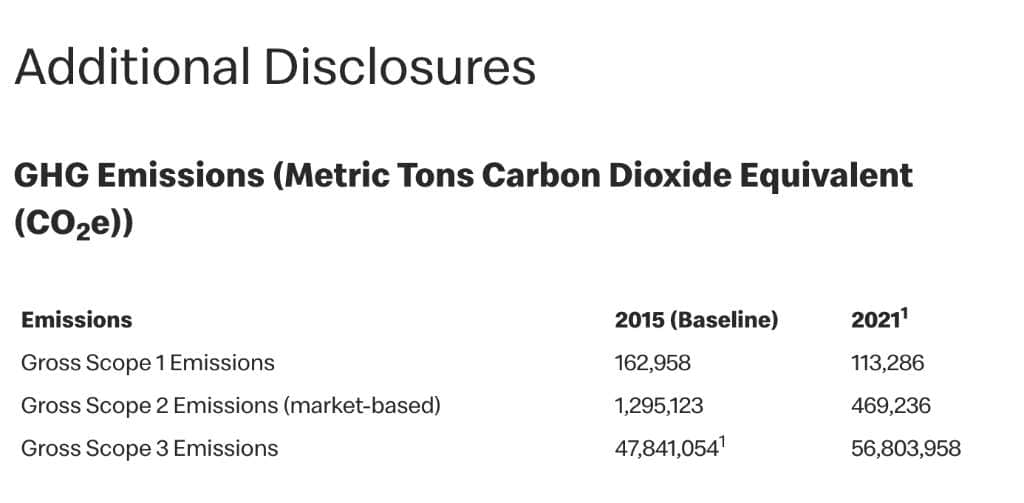
Scope 3 greenhouse gas (GHG) emissions, as defined in the GHG Protocol, are all indirect emissions along the corporate value chain. While they are optional to disclose they often account for the vast majority of emissions of an organization and offer tremendous potential for reduction strategies.
With growing regulatory and social pressure for companies to decarbonize, scope 3 has moved more into the spotlight. Moreover, stakeholders and investors both put more emphasis on the disclosure of these emissions in ESG reports than ever before.
In this ultimate guide to scope 3 GHG emissions in carbon accounting, we will take a deep dive into what scope 3 emissions are, how to account for them and how to include them in your ESG reports.
In addition, we will check out different reduction strategies and other steps you can take in your path to corporate Net Zero.
Let’s get started!
What are scope 3 GHG emissions in carbon accounting?
According to the GHG Protocol, Scope 3 includes all upstream and downstream greenhouse gas emissions linked to a company’s operations along its value chain that it does not produce on-site, outside of scope 2. They are optional to report but often account for the majority of corporate GHG emissions.
Scope 3 emissions are a consequence of a company’s operations or happen due to the consumption of an organization’s products and services. In contrast to scope 1, the sources for these emissions are owned or controlled by someone else.
This includes suppliers, customers, end-users of products, transportation, and end-of-life treatment.

For instance, when a customer of a car manufacturer uses fuel to drive, the greenhouse gas emissions from it will count toward the company’s scope 3 emissions. Other examples are the emissions from business travel or employee commuting between their homes and workplaces.
Indirect emissions related to purchased energy are excluded as these are part of scope 2.
It helps to remember that:
Your scope 3 emissions are someone else’s scope 1 and 2 emissions.
Scope 3 emissions are voluntary to disclose in GHG reports, however, it is important to measure them if Net Zero is the goal of your company.
That’s because depending on the type of business, corporate scope 3 emissions may actually be significantly larger than scope 1 and 2 emissions.
To offer a more comprehensive framework, the GHG Protocol Team released a separate standard on corporate scope 3 emissions in 2011.
GHG Protocol: Scopes 1, 2 & 3
Scope 1 emissions are direct emissions from owned or controlled sources, scope 2 emissions are indirect emissions from the generation of purchased energy, and scope 3 are other indirect emissions occurring along the company’s value chain.
For a refresher on the difference between the scopes, read our guide to scope 1, 2, and 3 emissions.
Scope 3 categories
The GHG Protocol classifies scope 3 emissions into 15 categories of upstream and downstream activities. Companies are free to use these categories as they apply to their operations, omit some or add their own if their business operations don’t fit into any of the existing ones.
Let’s look at both upstream and downstream activities a little closer. For each scope 3 category we will give you an example and a potential reduction strategy to look into.
Upstream Activities
Most upstream emissions are related to a company’s purchased or acquired goods and services which it uses to provide its own goods and services to customers.
Other main activities involve business travel and your employees’ commute to and from work.
We also refer to them as cradle-to-gate emissions.
The following scope 3 categories are included in a company’s upstream activities:
- Category 1 – Purchased Goods and Services
- Category 2 – Capital goods
- Category 3 – Fuel- and energy-related activities (not included in scope 1 or scope 2)
- Category 4 – Upstream transportation and distribution
- Category 5 – Waste generated in operations
- Category 6 – Business travel
- Category 7 – Employee commuting
- Category 8 – Upstream leased assets
Category 1 – Purchased Goods and Services
Upstream emissions from the provision of products purchased by the company, including tangible ones like physical products and intangible ones like services.
This category is reserved for general emissions which cannot be further specified (and thus would fall under one of the other scope 3 categories).
| Example | Emissions generated by a supplier to create motors that a manufacturer purchases to build and sell cars. |
| Reduction Potential | Incentivize your suppliers to measure and reduce their overall product lifecycle emissions. |
Reegy’s Scope 3 Emissions module allows you to further differentiate between production-related and non-production-related products when creating your scope 3 emissions inventory.
Category 2 – Capital goods
Emissions from producing physical assets used by your company to manufacture, sell, store, and deliver goods and services.
| Example | Assembly line equipment used to manufacture jet engines. |
| Reduction Potential | Incentivize your suppliers to measure and reduce their product lifecycle emissions for the capital goods you purchase. |
This category only applies to the production of the equipment or machinery at your company. Emissions from using them fall under your scope 1 or 2 emissions.
Capital goods vs Purchased goods
Sometimes the lines between these are blurry. Follow your financial accounting procedures to determine whether a particular product should reported in category 2 (capital goods) or 1 (purchased goods).
Category 3 – Fuel- and energy-related activities (not included in scope 1 or scope 2)
Any fuel and energy-related activities not covered by the other scopes. This excludes combustion emissions as these often fall under scope 2 (emissions from purchased energy).
Some activities included in category 3 are:
- Extraction or mining of energy sources
- Transmission and distribution (T&D) losses
- Generation of purchased electricity which is sold to others
| Example | Mining of coal or extraction of natural gas for heating purposes. |
| Reduction Potential | Switch to renewable energy or build on-site electricity generators. |
Calculating these energy-related activities can become incredibly complex, the more entities are involved along the energy generation value chain. For example, when extraction of the fossil fuels, power generation and distribution are carried out by separate companies.
Category 4 – Upstream transportation and distribution
All emissions from transportation and distribution of products purchased from tier 1 suppliers. This includes transportation activities from air, rail, road, or marine transport.
Category 4 applies only to inbound and outbound logistics not owned or operated by your company. If you own the trucks or cargo planes yourself, report them under scope 1.
| Example | Shipping of steel pipes from a supplier to a company’s production facility using multiple carriers. |
| Reduction Potential | Increase volume per shipping. |

Category 5 – Waste generated in operations
Emissions generated from third-party disposal and treatment of waste, including recycling. If you operate your own waste disposal facilities, they fall under scope 1 instead.
| Example | Disposal of waste in a landfill which emits methane (CH4) and nitrous oxide (N2O). |
| Reduction Potential | Reduce waste from packaging and your products. |
Category 6 – Business travel
All business travel-related emissions in vehicles not owned or operated by the company.
| Example | Taking an airliner and taxi to meet a client at their location. |
| Reduction Potential | Prefer online meetings over in-person or set up office close to your customers. |

Category 7 – Employee commuting
Emissions generated from employees commuting between their homes and workplaces.
| Example | Emissions of the cars of all employees not owned by the company. |
| Reduction Potential | Offer remote work or employee transportation on your premises |
Remote work
Some companies report emissions from their video conferencing via Zoom or MS Teams here, as well.
Category 8 – Upstream leased assets
Emissions from leased assets not accounted for in Scopes 1 and 2.
Inclusion of this category depends on the business model, as well as the chosen consolidation approach for your GHG emissions inventory. Some companies using the operational control approach rather assign emissions from leased buildings to their scope 1 and 2 inventories.
| Example | Emissions from heated warehouse to temporarily store company goods. |
| Reduction Potential | Switch to renewable energy in your leased assets. |
Downstream Activities
Downstream emissions are indirect GHG emissions related to sold goods and services, including end-of-life treatment.
This includes all emissions from the distribution and usage of your sold products and services by the end user.
We refer to them as gate-to-grave emissions.
While every company has downstream activities that incur GHG emissions, the way we report them depends on the types of products sold.
For example, if you sell raw materials like steel or unprocessed food, you might not know the end use of your products. This will make accounting for certain downstream scope 3 categories impossible.
If this is the case, you may disclose this in your reports, e.g. by marking a category with “not applicable“.
Category 9 – Downstream transportation and distribution
Emissions from vehicles used to transport and distribute goods and services not owned by your company. This only applies to those transportation activities after the company has already sold and distributed its products, for example, through an external marketplace.
| Example | Emissions from the shipping provider an online marketplace uses to sell your product to their customers. |
| Reduction Potential | Work with retailers to lower emissions from transportation and distribution. |
Category 10 – Processing of sold products
Emissions from further processing of a company’s sold goods to make final products.
Category 10 will not apply to companies selling directly to end-users.
| Example | Emissions from the furniture manufacturer from the wood purchased from your company. |
| Reduction Potential | Work with your customers to improve their emissions from operations. |
Category 11 – Use of sold products
The total expected lifetime emissions of the sold product by its end users including direct use-phase and indirect use-phase emissions.
These are the scope 1 and 2 emissions of your customers from using your products.
| Example | Fuel-related emissions from the car sold to an end-user or heating necessary to use pan for cooking. |
| Reduction Potential | Improve use-phase efficiency of your products |

Category 12 – End-of-life treatment of sold products
Emissions from disposal and treatment of products at the end of their life.
| Example | Disposal of broken laptop in a scrap yard. |
| Reduction Potential | Use recyclable components in your products. |
Category 13 – Downstream leased assets
Includes emissions from assets leased to others and not accounted for in Scopes 1 and 2.
Similarly to category 8, this may not apply to your company structure.
| Example | Emissions from a diesel truck a company leases to customers |
| Reduction Potential | Reduce GHG emissions from your leased assets. |
Category 14 – Franchises
Emissions from franchises of a company not included in other scopes.
| Example | Emissions from a restaurant as part of a food chain franchise. |
| Reduction Potential | Incentivize your franchisees to lower GHG emissions. |
Category 15 – Investments
Emissions from financial investments an organization has undertaken. This category is primarily designed for financial institutions, investors, as well as governmental organizations.
The GHGP divides such investments into four types:
- Equity investments
- Debt investments
- Project finance
- Managed investments and client services
| Example | Emissions from a renewable energy project a company has invested in. |
| Reduction Potential | Do your due diligence to find low GHG emitting projects. |

Carbon accounting for the financial industry experiences challenges of its own and can be very complex. However, analyzing your portfolio’s GHG emissions is not only necessary in order to achieve Net Zero, but can also be required by your regulatory body.
Reegy’s Portfolio Analytics Module gives financial institutions and investors insights into their portfolio’s carbon footprint, including benchmarking, emissions intensity, and changes throughout the year.
Why measure scope 3 GHG emissions?
Scope 3 emissions are voluntary to disclose in GHG reporting. However, in many cases, these indirect emissions have the largest environmental impact along the value chain. Therefore, it is highly recommended to track scope 3 emissions to achieve true Net Zero.
Most companies find it relatively easy to measure their scope 1 and 2 greenhouse gas emissions against their purchased fuel and electricity. Many are also able to take appropriate measures to reduce their carbon footprint in these areas on their own.
However, we often find that indirect upstream and downstream GHG emissions far exceed scope 1 and 2 ones. Once companies really start examining their entire value chain, they soon find out how large their actual greenhouse gas emissions are.
For example, IKEA reported that 20% of its entire GHG emissions, approximately 6 million metric tons, came from the use of sold products alone. Apple reports that around 99% of its emissions fall under scope 3, with a majority related to product manufacturing by third parties.
As you can see from this recent report from McDonald’s, this is a regular occurrence among the Fortune 500 and many other companies.

It becomes clear that for your organization to reach Net Zero and take meaningful climate action, you should absolutely measure and report your scope 3 emissions. Once you start doing so, you will most likely find huge reduction potential along your value chain.
Here are even more reasons why your company should measure, track, and analyze scope 3 emissions and include them in your corporate GHG inventory.
Understand GHG emission risks
Indirect GHG emissions from suppliers or customers pose great risks to businesses of any size. Rising energy costs, resource availability, and changing consumer preferences require management to take climate action sooner than later.
For example, Simon-Kucher found that in 2021 78% of consumers feel sustainability is important and want to adjust their lifestyle accordingly in the future.
Measuring scope 3 emissions as accurately as possible can reveal emissions-related risks and improve your company’s market position!
Detect reduction opportunities
Where there are risks, there are also opportunities. Establishing an accurate scope 3 emissions inventory can help uncover hidden emissions reduction potential along your value chain.
Potential benefits for your organization may include:
- Higher operational efficiency
- Cost savings
- Better products
- Increased customer loyalty
- Enhanced stakeholder relations
- …
For example, if you see that the transportation of raw materials from your supplier to your factory is a significant source of greenhouse gas emissions, you could look into increasing the volume per shipping.
On the other hand, if the use of your products by the end-user is a GHG “hot spot”, there could be a reduction potential of using more energy-efficient technologies or packaging.
Fulfill regulatory requirements
Every year, regulations around GHG emission caps and carbon accounting become stricter. Governments and sector regulatory bodies increasingly require disclosure of scope 3 emissions.
Even though this might not be the case in your region or industry, you can future-prove your company by accounting for your scope 3 emissions as soon as possible.
Joint climate action
Scope 3 emissions are linked to, but not produced by your organization directly. Therefore, you must work together with suppliers, customers, and other partners to reduce your greenhouse gas emissions.
Understanding where, how, and why your company produces significant indirect emissions is the first step in engaging these partners to take joint climate action to Net Zero.

Meet stakeholder requirements
Institutional investors and other stakeholders increasingly require ESG reports and disclosure of corporate GHG emissions. While the Corporate Standard only requires scopes 1 and 2 to be reported, it is common knowledge by now that scope 3 emissions are at least equally important.
A study from 2016 by the University of Oxford and Arabesque shows that in 80% of all cases, the stock price performance is positively correlated with good sustainable business practices.
Corporate reputation
It comes as no surprise that becoming a green company and following sustainable business practices increases the brand loyalty of customers and enhances stakeholder reputation.
We know that more than 83% of consumers will always pick a sustainable brand over others.
Establishing a corporate scope 3 emissions inventory displays your company’s efforts to take climate action and achieve Net Zero.
How to account for & report scope 3 GHG emissions
Now that you know what encompasses scope 3 emissions and why you want to measure them, here is a guide on how to do just that.
Please note that this is meant to give you a broad overview of scope 3 carbon accounting and you will need to refer to the GHG Protocol standards and other frameworks to create your inventory.
There is a 10-steps process involved in scope 3 accounting and reporting:
- Set your goals
- Identify all scope 3 activities
- Set the boundary
- Collect data
- Allocate emissions
- Set a reduction target
- Track emissions over time
- Assure emissions
- Report scope 3 emissions
- Continue tracking your emissions
1. Set your goals
Set goals for setting up your scope 3 inventory.
As we saw, there are so many sources of indirect emissions, clear goals are necessary to focus on the most important aspects. This could be to simply get an understanding of your overall emissions, reduce GHG emissions from certain value chain operations, or reduce use-phase impacts.
2. Identify all scope 3 activities
Understand what activities as part of your corporate value chain produce greenhouse gas emissions.
Go through each of the scope 3 categories above and how your company is involved in each aspect. Data from your ERP or CRM software can help, as well as tracking your purchases and travel statistics.
3. Set the boundary
Determine which scope 3 emissions you want to include in your analysis.
While your initial thought might be “all of them“, you will soon realize that this is near impossible or requires a lot of time and money.
Using a carbon footprint management software like Reegy can help you in setting the boundary right by analyzing your activity data. Our Scope 3 accounting module with its integrated machine-learning models will provide you with a good understanding of which emissions you should include and which ones can be omitted.
4. Collect data
Collect data from suppliers, employees, customers, and other partners along the value chain.
Once again, a good starting point is your ERP and CRM software, as well as purchase history, travel expenses, and contractual data. For factory outputs, utilize direct monitoring, mass balances, or stoichiometry.
You will then need to find energy emission factors for each activity and GWP (global warming potential) values to calculate CO2 equivalents from other greenhouse gas emissions such as NO2 or Methane (CH4).
You can find GWP values and emission factors in the databases of the Intergovernmental Panel on Climate Change (IPCC) or the United Nations Framework Convention on Climate Change (UNFCCC).
Reegy’s Eco Hub software makes data collection simple by integrating with many of the tools you use on a daily basis and hosting large databases of emission factors and GWP values. This way, you never have to look for the most recent publications and can save time on your carbon accounting!
5. Allocate emissions
Allocating emissions means breaking down facility or system output to the product level. For example, you might have the emissions data for your entire factory A, however, don’t know the exact distribution for the products made there.
In that case, you should use an allocation method to get down to the product level and subsequently account for emissions for each product line.
Allocation factors can be based on production, economic value, transportation, facility space, and more.
Product Lifecycle Emissions
A better choice than allocation is to follow the GHG Protocol’s Product Standard to carry out a product lifecycle analysis. This way, you can get the complete picture of product-level emissions and set better reduction targets.
6. Set a reduction target
Setting a science-based GHG emissions reduction target is optional but highly recommended.
Achieving Net Zero should be the goal of every company, but you are free to choose a target that suits your business best.
Consider the following things when setting your GHG reduction target:
- Target type
- Timeframe
- Level
- Potential measures
- Use of offsets or credits
7. Track emissions over time
Starting with a base year, track your scope 3 emissions over time until today.
Follow these steps to track scope 3 performance over time:
- Choose a base year
- Determine base year emissions
- Set scope 3 emissions reduction goals
- Account for scope 3 emissions
- Recalculate base year emissions (if necessary)
- Repeat these steps on an annual basis
They correspond to general carbon accounting procedures set by the GHG Protocol.
If you use our Reegy Eco Hub, we do base year calculations automatically for you, so you don’t lose track of it. Cool, huh?
8. Assure emissions
Assuring emissions usually means getting them verified and checked by third parties to increase credibility. A common verification standard is ISO 14064-3.
This step is optional but highly recommended to ensure integrity in the eyes of regulators and investors.
9. Report scope 3 emissions
Report all scope 1, 2, and 3 emissions according to the GHG Protocol Corporate Standard or any other applicable carbon accounting standard for your industry.
For each scope 3 category, include details on your activity data, emission factors, and global warming potential (GWP) values.
Reegy offers several options for the automatic creation of your carbon accounting reports including GHG Protocol, ISO, GRI, and PCAF.
10. Continue tracking your emissions
After your initial scope 3 inventory has been established, you need to keep tracking your emissions over time.
This helps to check the progress of your science-based reduction targets and is necessary for subsequent reports in upcoming years.
How to select relevant scope 3 emissions to disclose?
The easiest way to select which scope 3 activities and categories to report is by analyzing them in regard to significance. This includes their size relative to overall GHG emissions, their influence on the value chain, and associated risks.
Some criteria you may apply to your scope 3 GHG inventory are:
- Size: Are contributions significant?
- Data: Can I obtain reliable data on these emissions?
- Influence: Can we change these somehow?
- Risk: What climate risks are involved?
- Stakeholders: How do stakeholders assess these emissions?
- Outsourcing: How does outsourcing influence our emissions?
- Sector guidance: Are they considered insignificant in our sector?
- Other: Any other criteria you deem appropriate
Reegy’s scope 3 module helps you identify relevant scope 3 emissions and account for them appropriately.
How to reduce scope 3 emissions
Accounting for and disclosing scope 3 emissions is great, but reducing greenhouse gas emissions is even better.
Here are some examples of actions to reduce your scope 3 GHG emissions:
- Implement low-GHG purchasing policies
- Replace business travel with online meetings
- Reduce transportation emissions by lowering the distance between supplier and customer
- Source and produce locally
- Reduce fossil-fuel use
- Reduce waste from your products
- Offer home office to reduce employee commuting
- Develop new low-GHG products
- Turin to recyclable products
- Analyze your investment portfolio for lower-emitting alternatives
There are countless opportunities and options available and every organization can effectively lower their scope 3 GHG emissions.
Why is measuring scope 3 GHG emissions difficult?
While companies can usually determine scope 1 and 2 emissions with relative ease, scope 3 encompasses a variety of emission categories from outside sources. This poses challenges in obtaining reliable data from suppliers or customers and makes scope 3 costly and time-consuming.
Direct scope 1 emissions from operations are usually straightforward to measure and scope 2 data from energy providers is readily available. Of course, this may be different for your particular case, but it generally holds true.
On the other hand, many of the scope 3 GHG emissions along the value chain are outside an organization’s control. Finding reliable data from suppliers, customers, and partners can be difficult and must be repeated for each reporting year.
While our 10-step process from above looks simple in theory, large companies with numerous product offerings will soon find that it is not at all easy.
This is why scope 3 is often considered the “holy grail” of carbon accounting.
What can we do?
The GHG Protocol’s Guidance on Scope 3 accounting can be a good starting point to look into for your first corporate GHG emissions inventory. If you already have an accounting system established, ISO and other norms offer additional frameworks.
Alternatively, you can work with consultants or ESG and CSR agencies to work out your corporate carbon footprint.
Unfortunately, both options will either cost a lot of time for your ESG department or incur major costs when getting outside help.
As we will see next, carbon footprint management software can help take the complexity out of GHG reporting with a much greater ROI than manual carbon accounting or hiring consultants.
Why you should use carbon accounting software to report scope 3 emissions
Carbon Footprint Management solutions or climate action and carbon accounting platforms can significantly reduce the effort needed to measure, analyze, and report GHG emissions.
More importantly, they aid in finding potential reduction strategies and let you focus on the core aspect of carbon accounting: Reduce your overall carbon footprint and take meaningful climate action!
Reegy’s Software-as-a-Service solutions allow detailed scope 1, 2, and 3 emissions tracking, and our advanced AI can propose different reduction strategies based on your decarbonization targets.
Key Takeaways
The GHG Protocol and other carbon accounting standards have traditionally proposed that scope 3 emissions are optional for companies to disclose. And truly, if the whole world reported their scope 1 and 2 emissions in full, we would not need them.
However, it’s unlikely and near impossible that this will ever be the case. After all, without regulatory measures, most end users and individuals will not (nor be able to) measure their exact carbon footprint and report it, too.
If everyone reported their scope 1 and 2 emissions in full, we would not need to measure scope 3. However…that’s unlikely to ever be the case.
Therefore, measuring, accounting for, and reporting your scope 3 emissions is a big step toward achieving Net Zero.
Data collection, analysis, and appropriate reduction strategies can be challenging but with the right goals in mind, you can skip many of the common pitfalls in carbon accounting.
Reegy’s Eco Hub can help you and your company on its decarbonization journey and save you both time and money while doing so
Reegy is a complete software solution for ESG & Carbon Footprint Management. Our Reegy Eco Hub enables enterprises, financial institutions and governmental organizations to manage their climate action in one central location along the entire value chain. Track, measure, reduce, and offset your carbon emissions, disclose them to regulators, stakeholders, and customers and lead your company to Net Zero on autopilot!